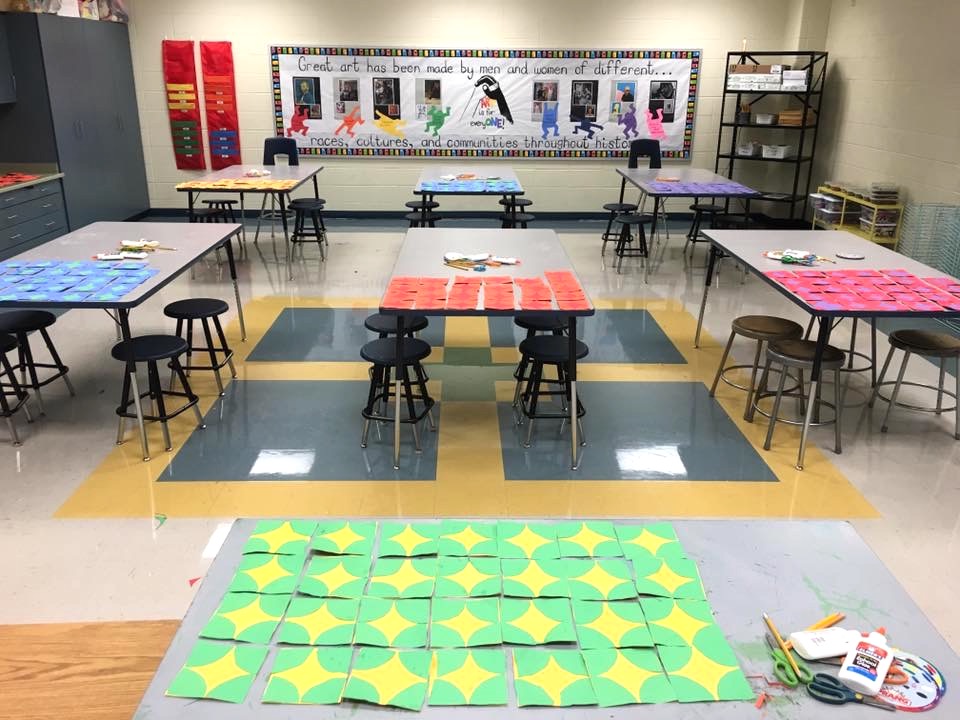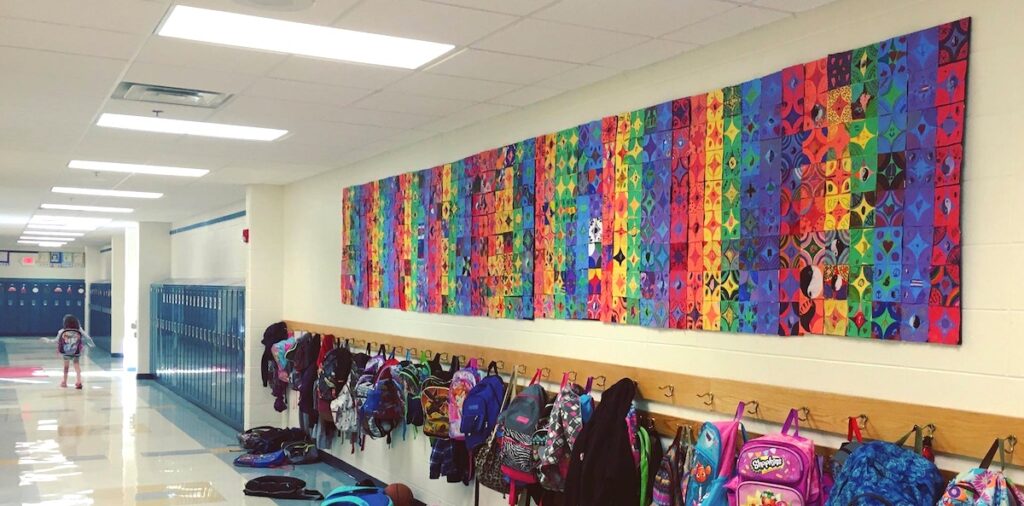Art offers a positive gateway to address both personal and community crisis and trauma. Throughout history, artists have expressed feelings of injustice in their work. Thus, it’s important to provide your students with an opportunity to express how they feel visually and creatively about a variety of subjects and themes. Students have a lot to say about their own lives and how they see the world. Sometimes we hear the words social justice, or civic engagement, or community involvement and think this is too heavy of a topic for young students, but there are age-appropriate ways to address these issues at every grade level.
One wonderful way for elementary students to understand community and civic engagement is through quilt design.

- Read: Carol Swartout Klein’s children’s book, Painting for Peace in Ferguson. This book tells the story of the community painting effort and showcases the dramatic and colorful paintings created on the boarded-up windows and doors after the 2014 unrest in Ferguson, Missouri. This is a great book to introduce at the elementary level because it does not go into the specifics of what caused the unrest but focuses on the way the community came together to begin the healing process through art.
- Symbol Search: After sharing this children’s book with your class, you can have students start to look for symbols in the Ferguson artwork. Students may point out symbols like doves, peace signs, hearts, and others that reflect love, respect, and community. Many of the paintings also feature words and quotes promoting peace. You can ask students to interpret some of the meanings behind each quote and why these images and words would be painted on the boards.
- Brainstorm: After students have identified symbols and quotes in the Ferguson paintings, they can work together to brainstorm other symbols. Ask the class for ideas of symbols that would represent love, peace, acceptance, etc. Write these on the board as a bank of symbols students may eventually choose from. At first, you may receive some pretty predictable ideas, but as those go up on the board, students will start to think more creatively. Ask them what the word peace means? Respect? Love? Ask them what images come to mind when they hear each word. While a heart shape may be the first association for the word love, can they think of other ways to draw it?
- Create: Once you have a strong list of symbols reflecting these universal ideas of acceptance and peace, students can get to the artmaking! Explain to the class they will be creating a collaborative paper quilt. While this quilt isn’t a real quilt that can keep us warm, it will be created by a similar process of piecing squares together. Each student will be responsible for creating one paper square that represents a concept like peace, love, respect, or happiness. How the student chooses to visually communicate this message is up to them.

The reason for using a quilt design for this community and civic engagement lesson is to demonstrate to students how each of them can play a part in showing others respect. The finished quilt will have a big impact because it will be large and colorful, and everyone in the school will stop to look at how awesome it is! However, the finished quilt would not be complete if even one square is missing, so every student’s contribution is vital just as every student is a vital part of your school community. Everyone should feel safe, respected, and accepted in their community.
More connections
1. Elements and Principles
This lesson is also an opportunity to bring in some of the elements of art and principles of design, and to encourage students to apply what they know. You may instruct the class to use a specific color scheme of construction paper scraps. You could require their design to have radial balance or symmetry. Whatever elements and principles you want to incorporate, students can still apply a symbol to their design. While the concept of this project may be social justice, you can work in some art skills, as well.
2. Mathematical Fractions in Art
Another skill you could tie into this paper quilt project is to talk to students about fractions. One easy way to make a symmetrical quilt design is to start with two different colored square pieces of paper. Ask students to trace a circle on one of the squares and cut it out. Now ask them to cut it in half, and then in fourths. They now have four pizza slices of paper. Instruct students to glue one slice in each corner of their remaining square paper. Just like that, they have an interesting design with symmetrical balance. They can draw their symbol in the middle, or different symbols in each corner!

3. Planning for an Impressive Display
One thing to consider when doing a large collaborative project like this is the end product. If you’re having all of your classes create a square, you’re going to want to maintain some sense of organization, and have a visually-appealing display when it’s done. One way you can achieve this is by controlling some of the color choices for your classes. If you have twelve classes, try assigning a color for every two classes. You will know Class A and Class B are using blue squares, and Class C and Class D are using red squares, etc. This helps you keep track of everything, and ensures you have a balanced variety of colors for the final display.

When you’re ready to hang the work, think about making smaller panels to assemble the larger display. Instead of hanging up each individual square on its own, assemble a poster board full. Then attach the poster to the wall or bulletin board. This makes for more manageable assembly and tear down. You can tape or glue squares to the poster board more easily in your classroom, and then transport the poster to the hall or display area as they are finished. It’s much easier hanging ten poster boards full of art than stapling in hundreds of paper squares. Think smarter, not harder!
For more ideas on collaboration and community see 29 Collaborative Projects to Build Community in Your Art Room.
Final Thoughts
Community and civic engagement don’t have to be scary topics for your students. There are resources out there, like children’s books, to help initiate these conversations. Students have their own opinions about the world they live in, and you can help facilitate positive discussions. As their art teacher, you can help them learn how to express these big ideas in creative and visual ways.
A collaborative project like this shows every student they are a part of a larger community, and they can contribute to something great. This is a great analogy for life, as well. Your students may feel like they are not a big part of their school, but you can show them the integral role they play in your class!
How do you approach social justice issues in the art room?
What collaborative projects do you teach?
What quilt-inspired projects have been successful in your art room?
Magazine articles and podcasts are opinions of professional education contributors and do not necessarily represent the position of the Art of Education University (AOEU) or its academic offerings. Contributors use terms in the way they are most often talked about in the scope of their educational experiences.





